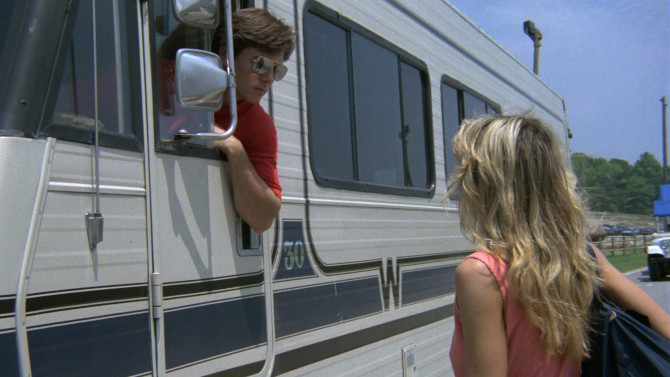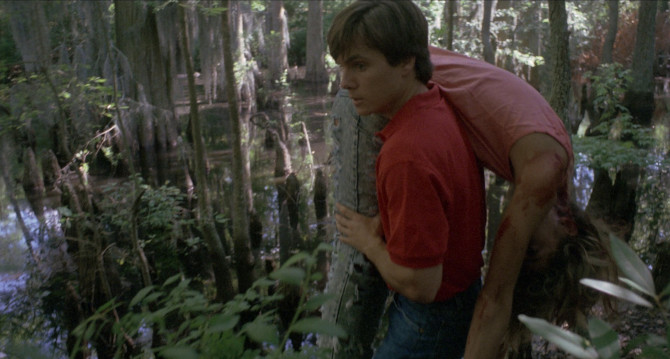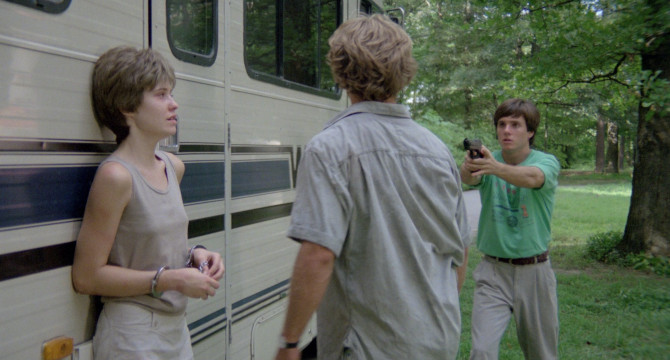‘What Could Have Been’ is a continuing look into the reels of film history, analysing movies that could have been something special, but due to problems with script, production, budgetary, or any other type of issue, did not reach its full potential.
In the late 1980s, Italian director Umberto Lenzi, best known for his giallo and horror fare – think Seven Blood-Stained Orchids and Knife of Ice, came to America to work with fellow Italian film maker Joe D’Amato (the man had been Lenzi’s cinematographer on 1970’s A Quiet Place to Kill). Making four films together in two years, the one to be looked at here today is 1989’s Hitcher in the Dark. . . a bizarre flip-the-script hybrid between the recently successful horror movie The Hitcher (1986) and the ever successful Alfred Hitchcock picture Psycho (1960).
Following a mentally disturbed man in his early twenties, Mark Glazer (Joe Balogh) has a rather sick obsession (both sexual and violent) with his mother – the whole issue stemming from the fact she abandoned the family when he was only ten years old to schtup the local tennis pro (I’m sure the athlete is still claiming game, set, and match).
With a father (Robin Fox) more interested in running his multi-million dollar hotel empire than giving his son much attention, he has bought Mark a decked out RV to tour the country in (and to get him out of his hair). Bumping into several attractive hitchhiking women who could be deemed to have the worst instincts ever, the psycho picks them up, tossing them into alligator infested swamps after he is done with them.
Eventually ‘rescuing’ Daniella Foster (Josie Bissett) from her kiss-anything-in-sight boyfriend, Kevin (Jason Saucier), she gets to take a ride in Mark’s mystery machine (and, unlike in Scooby-Doo, the snacks aren’t safe – zoinks!).
Making a deranged connection, Mark somehow likens this new girl to his mother (a bit of a stretch when you see a photo of the missing matriarch). . . meaning that this won’t be a smash and death dash scenario, but rather, a long, drawn out affair. Leading to a battle of strengths and wills, Mark is hoping to transform the young woman into his mother – who knew he was such a talented fashionista and hairdresser (and let’s not forget his creepy photography skills).
Though don’t count Daniella out, for she is a survivor, and not without some mind tricks of her own. She will scheme, prod, and yes, at times scream, while her failure of a boyfriend has now decided that he can’t live without her and will drive around aimlessly throughout the country until he finds her (sounds like a good plan). Could Sigmund Freud even help this mommy dearest issue? Might this entire breakdown stem from a monotonous and lengthy trip by a single person in an RV? Perhaps Mark would find some solace slicing balls like his mother’s new beau.
Not truly capturing the terror of either of the movies that influenced it, Hitcher in the Dark is not without its style and successes. Intriguingly, Lenzi decides to juxtapose the tension by finding well populated areas (often in broad daylight). Beaches, drive-in movie theatres, gas stations, and RV dealerships become part of the suspense. . . furthering the will she/won’t she be rescued storyline. It is a most unique idea, and a process not generally used.
With a rather far-fetched ending (that Lenzi was forced to shoot to appease higher-ups), Hitcher in the Dark may not be his original vision, but it does have its moments. Decently acted (it actually does a solid job getting into the mind of a young adult who has devolved into a traveling psychopath due to early age family issues), at times quite suspenseful, and twistedly engaging, it may be the place you want to go after seeing Lenzi’s earlier and more well respected features. So, pull this one out of the junkyard and into the RV – odds are, it still might be better than some of your family road trips.




Always pleasurable reading your review. Well done Nikolai 👏👏👏
Thanks, Amit!